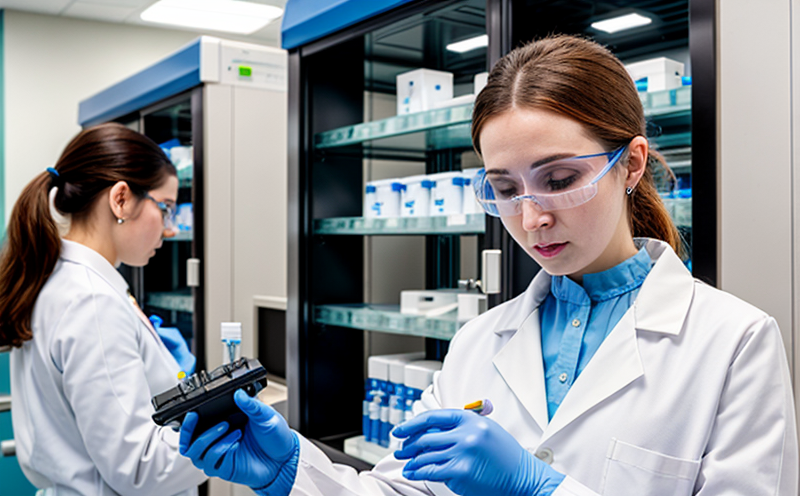Microextraction by Packed Sorbent Bioanalysis Testing
The process of Microextraction by Packed Sorbent (MEPS) bioanalysis is a sophisticated and precise method employed in pharmaceutical testing to ensure the purity, efficacy, and safety of medicinal products. This technique involves the concentration and extraction of analytes from complex matrices using packed sorbents within microscale volumes. The MEPS method allows for enhanced sensitivity and selectivity, making it ideal for bioanalytical applications where trace levels of compounds are critical.
This approach is particularly beneficial in the development phase of new pharmaceuticals, where accurate quantification of active ingredients or potential impurities is paramount. The technique minimizes sample consumption while maximizing recovery rates, which is crucial when dealing with limited biological samples such as blood plasma or tissue extracts. By leveraging advanced analytical instrumentation like Liquid Chromatography-Mass Spectrometry (LC-MS), MEPS ensures reliable and reproducible results.
The methodology involves several key steps: initial preparation of the sample, introduction into a packed sorbent cartridge, solvent elution to transfer the analyte onto the sorbent phase, desorption with a mobile phase in the analytical instrument, and finally, detection using sensitive techniques. This process allows for the selective extraction of target compounds from complex biological fluids without compromising their integrity.
The precision and accuracy achieved through MEPS make it an indispensable tool in ensuring compliance with international standards such as ISO 17025 for laboratory testing and calibration services. Compliance officers can rely on this method to meet stringent regulatory requirements, thus safeguarding public health by delivering high-quality pharmaceuticals.
In summary, Microextraction by Packed Sorbent bioanalysis is a cutting-edge technique that enhances the efficiency and reliability of bioanalytical testing in pharmaceutical research and development. It supports quality managers and R&D engineers in achieving their goals by providing robust data necessary for informed decision-making processes.
Scope and Methodology
| Step | Description |
|---|---|
| Sorbent Preparation | Selecting appropriate sorbents based on the analyte characteristics. |
| Sample Introduction | Loading the sample into a microscale cartridge containing packed sorbents. |
| Extraction | Using solvent to extract analytes from the sample matrix onto the sorbent phase. |
| Desorption | Eluting the extracted analyte into a mobile phase suitable for analytical instruments. |
| Detection | Analyzing the desorbed compound using LC-MS or other sensitive detection methods. |
| Data Interpretation | Evaluating results against predefined acceptance criteria to ensure accuracy and precision. |
Why Choose This Test
The Microextraction by Packed Sorbent bioanalysis testing offers several advantages over conventional extraction methods, making it a preferred choice for pharmaceutical testing:
- Sensitivity and Selectivity: MEPS enhances the detection limits of analytes in complex matrices.
- Sample Efficiency: It minimizes sample usage while maximizing recovery rates, which is especially important when dealing with limited biological samples.
- Precision: The technique provides highly accurate and reproducible results, crucial for maintaining quality standards.
- Compliance: Adherence to international standards ensures regulatory compliance and public safety.
- Rapid Turnaround Time: Shorter processing times contribute to quicker product development cycles.
These benefits make MEPS bioanalysis a reliable option for pharmaceutical companies aiming to produce safe, effective, and high-quality medicinal products. Compliance officers can leverage this method to streamline their regulatory processes and ensure continuous improvement in product quality.
Environmental and Sustainability Contributions
- Sustainable Resource Use: MEPS reduces the amount of solvent required for extraction, thereby conserving resources.
- Minimized Waste: By optimizing sample usage and recovery rates, MEPS helps minimize waste generation.
- Eco-Friendly Techniques: The use of advanced analytical instruments supports greener laboratory practices.
- Reduced Energy Consumption: Efficient methods like MEPS help in reducing the overall energy footprint of testing processes.
The adoption of such sustainable practices not only aligns with corporate social responsibility goals but also contributes positively to environmental conservation efforts. By integrating these methodologies into their workflows, pharmaceutical manufacturers can play a significant role in promoting sustainability within the industry.





